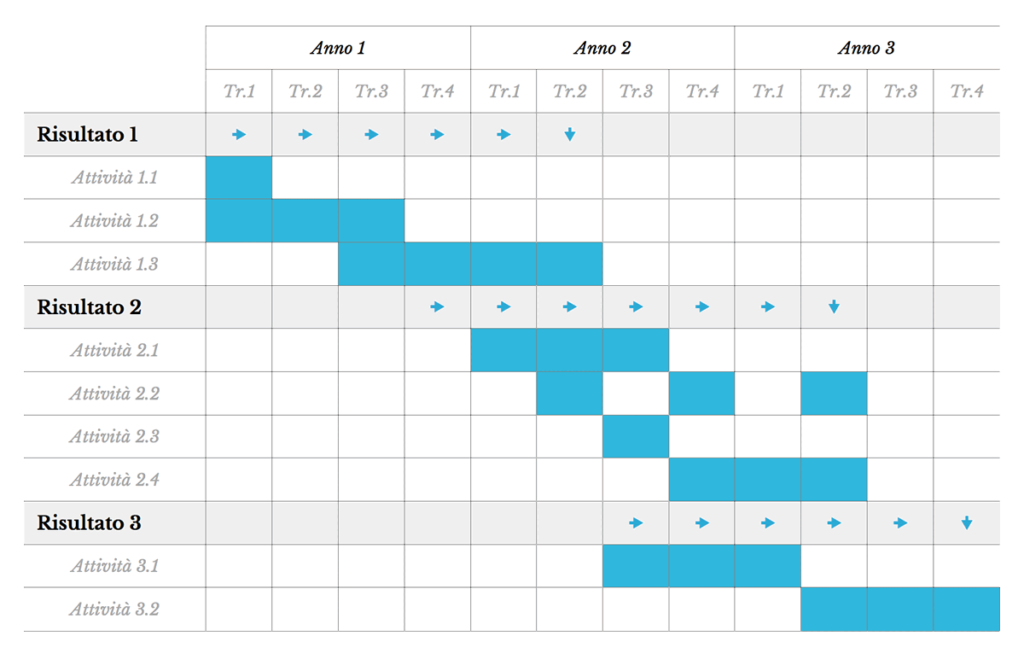The search for information is an ongoing process, involving the formulation of the project idea and extending to the identification of the call for proposals, the presentation of the project, and even its subsequent execution. The purposes of this research are first and foremost to thematic nature and reside:
- in the need to present as timely and up-to-date a proposal as possible;
- in the necessary verification that the project idea contains elements of innovation, is not redundant with existing projects, and capitalizes on previous experience;
- in the importance of understanding which organizations (territorial actors, organizations or companies) are already active in the same sector, in the reference territory and in Europe, from whose experience to draw insights and with whom to develop possible partnerships;
- in the fact that a thorough knowledge of the area in which the project operates is an indication of reliability and credibility and is an important element for a positive evaluation by the funding agency.
Second, but no less important, the information search also involves monitoring the main sources of information on programs, calls for proposals and related deadlines. As illustrated in the previous sections, reference sources vary depending on the type of projects.
Main sources of information for projects funded by the regional or national operational programs:
- Dedicated sections within websites of managing authorities (regional authorities or the Italian government), usually under the title “calls and funding” (see detail provided in previous sections);
- National and regional official journals;
- Newsletters and information materials available (in hard copy and online) from Chambers of Commerce, trade associations and specialized organizations;
- National or regional planning documents (outlined in the previous sections), which provide insight into which strategic investment areas and on which axes funding opportunities will open up.
Main sources of information for projects funded by the directly managed community programs:
Dedicated services for researching calls for proposals, including the Infobandi service of CSVnet proposed by this Guide.
Through the same sources it is often possible to obtain information regarding projects carried out under previous calls and partner search tools.
In fact, projects are normally designed and implemented in partnership: It is very rare for an organization alone to possess all the technical and financial capabilities to carry out a project. The principle of partnership lies in adopting a network approach, aimed at bringing together complementary skills and capabilities (technical and financial).
The management of a partnership is the responsibility of the Lead Partner (or Project Coordinator), who is responsible for:
- Managing the relationship with all partners, defining and coordinating the division of tasks and responsibilities from the development of the project proposal to the end of the project, ensuring internal communication between partners;
- Draw up a partnership agreement (partnership/consortium agreement) in which all organizational, legislative and economic provisions are signed by the project partners;
- Manage relations with the funding agency on behalf of the partnership.
Finding project partners can be complex. In addition to the sources mentioned above, there are numerous databases of experts and entities active in the field (categorized by area of expertise) that can be drawn upon.
Like the timing, the costs Of the project should not be underestimated. Project preparation itself is an activity that employs extensive resources of time and personnel. Cost estimation for project execution and subsequent budget preparation is a complex activity in which careful consideration must be given:
- The existence of specific items of expenditure eligible for funding, which must be adhered to;
- The existence of a maximum threshold for funding by the call (both in absolute value and percentage) and the need to provide for adequate co-funding;
- The need to allocate burdens, benefits and responsibilities fairly and functionally among partners;
- The existence of specific budget calculation forms (sometimes quite complex);
- The need to provide a proper cost estimate (the project should not result in a loss for the proposers, but too high a budget, particularly if not justified, may reduce the chances of award).
The effort required to prepare a European project and the constraint of the co-financing (necessary for most European projects) imply that the community contribution is conditional-first and foremost-on some form of investment by the proposing entities. As mentioned above, the percentage of European co-financing varies depending on the type of projects.
Part of the co-funding can be covered directly by project partners through the enhancement of internal staff (man hours).
In some programs and exclusively for public (or assimilated) entities, the co-financing share may be covered by the Italian ministerial revolving fund.
With a view to synergy among European projects, community programming provides the possibility of cumulate Community funding from community programs and structural funds. This is limited to some programs and excludes double coverage of the same cost categories.
Finally, when designing a project, it is necessary to carefully evaluate the human resources dedicated.
At least two people should be included in the proposal preparation phase: a technical expert in the subject matter and a project manager, responsible for coordination with partners and management of the more administrative part, related to typical European project procedures.
In building the project, it is necessary to assess who and for how long will actually be able to work on the planned activities, forming the future “working group” of the project. The human resources involved may be part of the staff of the proposing organization or may be hired specifically for the implementation of the project. The main elements used to assess the quality of the team are previous experience, the extent of time spent on the project, the feasibility of the workload, the complementarity of skills, and their correspondence to what the project activities are expected to achieve.

